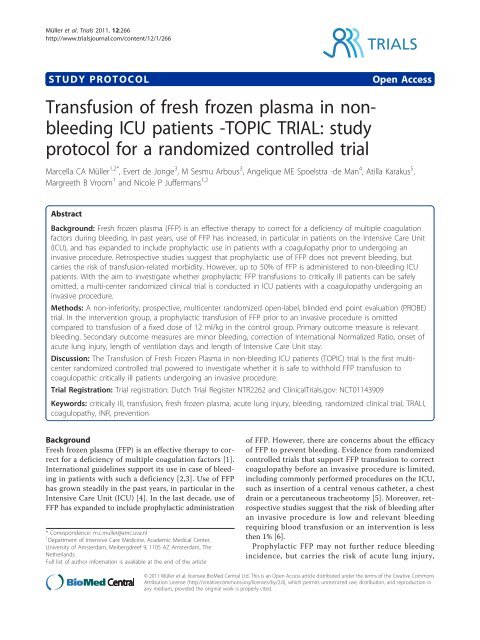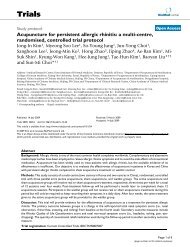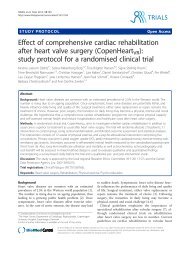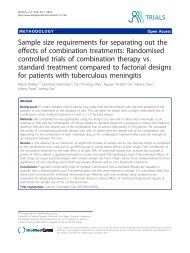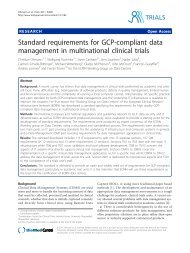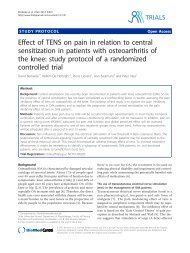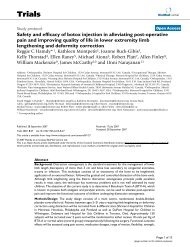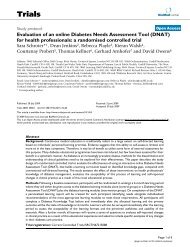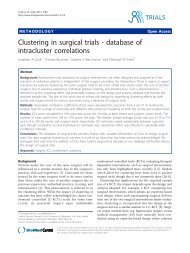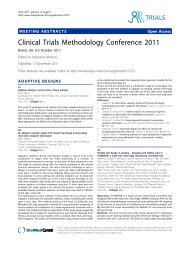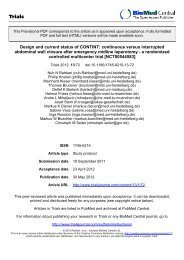Transfusion of fresh frozen plasma in non-bleeding ICU ... - Trials
Transfusion of fresh frozen plasma in non-bleeding ICU ... - Trials
Transfusion of fresh frozen plasma in non-bleeding ICU ... - Trials
You also want an ePaper? Increase the reach of your titles
YUMPU automatically turns print PDFs into web optimized ePapers that Google loves.
Müller et al. <strong>Trials</strong> 2011, 12:266<br />
http://www.trialsjournal.com/content/12/1/266<br />
TRIALS<br />
STUDY PROTOCOL<br />
Open Access<br />
<strong>Transfusion</strong> <strong>of</strong> <strong>fresh</strong> <strong>frozen</strong> <strong>plasma</strong> <strong>in</strong> <strong>non</strong>bleed<strong>in</strong>g<br />
<strong>ICU</strong> patients -TOPIC TRIAL: study<br />
protocol for a randomized controlled trial<br />
Marcella CA Müller 1,2* , Evert de Jonge 3 , M Sesmu Arbous 3 , Angelique ME Spoelstra -de Man 4 , Atilla Karakus 5 ,<br />
Margreeth B Vroom 1 and Nicole P Juffermans 1,2<br />
Abstract<br />
Background: Fresh <strong>frozen</strong> <strong>plasma</strong> (FFP) is an effective therapy to correct for a deficiency <strong>of</strong> multiple coagulation<br />
factors dur<strong>in</strong>g bleed<strong>in</strong>g. In past years, use <strong>of</strong> FFP has <strong>in</strong>creased, <strong>in</strong> particular <strong>in</strong> patients on the Intensive Care Unit<br />
(<strong>ICU</strong>), and has expanded to <strong>in</strong>clude prophylactic use <strong>in</strong> patients with a coagulopathy prior to undergo<strong>in</strong>g an<br />
<strong>in</strong>vasive procedure. Retrospective studies suggest that prophylactic use <strong>of</strong> FFP does not prevent bleed<strong>in</strong>g, but<br />
carries the risk <strong>of</strong> transfusion-related morbidity. However, up to 50% <strong>of</strong> FFP is adm<strong>in</strong>istered to <strong>non</strong>-bleed<strong>in</strong>g <strong>ICU</strong><br />
patients. With the aim to <strong>in</strong>vestigate whether prophylactic FFP transfusions to critically ill patients can be safely<br />
omitted, a multi-center randomized cl<strong>in</strong>ical trial is conducted <strong>in</strong> <strong>ICU</strong> patients with a coagulopathy undergo<strong>in</strong>g an<br />
<strong>in</strong>vasive procedure.<br />
Methods: A <strong>non</strong>-<strong>in</strong>feriority, prospective, multicenter randomized open-label, bl<strong>in</strong>ded end po<strong>in</strong>t evaluation (PROBE)<br />
trial. In the <strong>in</strong>tervention group, a prophylactic transfusion <strong>of</strong> FFP prior to an <strong>in</strong>vasive procedure is omitted<br />
compared to transfusion <strong>of</strong> a fixed dose <strong>of</strong> 12 ml/kg <strong>in</strong> the control group. Primary outcome measure is relevant<br />
bleed<strong>in</strong>g. Secondary outcome measures are m<strong>in</strong>or bleed<strong>in</strong>g, correction <strong>of</strong> International Normalized Ratio, onset <strong>of</strong><br />
acute lung <strong>in</strong>jury, length <strong>of</strong> ventilation days and length <strong>of</strong> Intensive Care Unit stay.<br />
Discussion: The <strong>Transfusion</strong> <strong>of</strong> Fresh Frozen Plasma <strong>in</strong> <strong>non</strong>-bleed<strong>in</strong>g <strong>ICU</strong> patients (TOPIC) trial is the first multicenter<br />
randomized controlled trial powered to <strong>in</strong>vestigate whether it is safe to withhold FFP transfusion to<br />
coagulopathic critically ill patients undergo<strong>in</strong>g an <strong>in</strong>vasive procedure.<br />
Trial Registration: Trial registration: Dutch Trial Register NTR2262 and Cl<strong>in</strong>ical<strong>Trials</strong>.gov: NCT01143909<br />
Keywords: critically ill, transfusion, <strong>fresh</strong> <strong>frozen</strong> <strong>plasma</strong>, acute lung <strong>in</strong>jury, bleed<strong>in</strong>g, randomized cl<strong>in</strong>ical trial, TRALI,<br />
coagulopathy, INR, prevention<br />
Background<br />
Fresh <strong>frozen</strong> <strong>plasma</strong> (FFP) is an effective therapy to correct<br />
for a deficiency <strong>of</strong> multiple coagulation factors [1].<br />
International guidel<strong>in</strong>es support its use <strong>in</strong> case <strong>of</strong> bleed<strong>in</strong>g<br />
<strong>in</strong> patients with such a deficiency [2,3]. Use <strong>of</strong> FFP<br />
has grown steadily <strong>in</strong> the past years, <strong>in</strong> particular <strong>in</strong> the<br />
Intensive Care Unit (<strong>ICU</strong>) [4]. In the last decade, use <strong>of</strong><br />
FFP has expanded to <strong>in</strong>clude prophylactic adm<strong>in</strong>istration<br />
* Correspondence: m.c.muller@amc.uva.nl<br />
1 Department <strong>of</strong> Intensive Care Medic<strong>in</strong>e, Academic Medical Center,<br />
University <strong>of</strong> Amsterdam, Meibergdreef 9, 1105 AZ Amsterdam, The<br />
Netherlands<br />
Full list <strong>of</strong> author <strong>in</strong>formation is available at the end <strong>of</strong> the article<br />
<strong>of</strong> FFP. However, there are concerns about the efficacy<br />
<strong>of</strong> FFP to prevent bleed<strong>in</strong>g. Evidence from randomized<br />
controlled trials that support FFP transfusion to correct<br />
coagulopathy before an <strong>in</strong>vasive procedure is limited,<br />
<strong>in</strong>clud<strong>in</strong>g commonly performed procedures on the <strong>ICU</strong>,<br />
such as <strong>in</strong>sertion <strong>of</strong> a central venous catheter, a chest<br />
dra<strong>in</strong> or a percutaneous tracheotomy [5]. Moreover, retrospective<br />
studies suggest that the risk <strong>of</strong> bleed<strong>in</strong>g after<br />
an <strong>in</strong>vasive procedure is low and relevant bleed<strong>in</strong>g<br />
requir<strong>in</strong>gbloodtransfusionoran<strong>in</strong>terventionisless<br />
then 1% [6].<br />
Prophylactic FFP may not further reduce bleed<strong>in</strong>g<br />
<strong>in</strong>cidence, but carries the risk <strong>of</strong> acute lung <strong>in</strong>jury,<br />
© 2011 Müller et al; licensee BioMed Central Ltd. This is an Open Access article distributed under the terms <strong>of</strong> the Creative Commons<br />
Attribution License (http://creativecommons.org/licenses/by/2.0), which permits unrestricted use, distribution, and reproduction <strong>in</strong><br />
any medium, provided the orig<strong>in</strong>al work is properly cited.
Müller et al. <strong>Trials</strong> 2011, 12:266<br />
http://www.trialsjournal.com/content/12/1/266<br />
Page 2 <strong>of</strong> 7<br />
occurr<strong>in</strong>g <strong>in</strong> up to 30% <strong>of</strong> transfused <strong>ICU</strong> patients [7],<br />
result<strong>in</strong>g <strong>in</strong> an <strong>in</strong>creased duration <strong>of</strong> mechanical ventilation<br />
and <strong>ICU</strong> stay [8,9]. However, despite the absence <strong>of</strong><br />
evidence, <strong>in</strong> our <strong>ICU</strong> patients, 33% <strong>of</strong> <strong>plasma</strong> is transfused<br />
to <strong>non</strong>-bleed<strong>in</strong>g patients[10],whichis<strong>in</strong>accordance<br />
with reports on <strong>ICU</strong> transfusion practice <strong>in</strong><br />
Europe and the United States [11,12].<br />
With the aim to <strong>in</strong>vestigate whether prophylactic FFP<br />
transfusions to critically ill patients can be safely<br />
omitted, a multi-center randomized cl<strong>in</strong>ical trial is conducted<br />
<strong>in</strong> <strong>ICU</strong> patients with a coagulopathy undergo<strong>in</strong>g<br />
an <strong>in</strong>vasive procedure.<br />
Methods/Design<br />
Objectives and design<br />
Theprimaryobjective<strong>of</strong>the‘<strong>Transfusion</strong> <strong>of</strong> <strong>fresh</strong> <strong>frozen</strong><br />
Plasma In <strong>non</strong>-bleed<strong>in</strong>g Critically ill’ trial (’TOPIC’<br />
trial) is to assess whether omitt<strong>in</strong>g prophylactic FFP<br />
transfusion is <strong>non</strong>-<strong>in</strong>ferior to prophylactic FFP transfusion<br />
(current practice) to prevent relevant bleed<strong>in</strong>g <strong>in</strong><br />
<strong>ICU</strong> patients with a coagulopathy, who are undergo<strong>in</strong>g<br />
an <strong>in</strong>vasive procedure.<br />
The preferred design to demonstrate the <strong>non</strong>-<strong>in</strong>feriority<br />
<strong>of</strong> no FFP transfusion prior to an <strong>in</strong>vasive procedure<br />
aga<strong>in</strong>st FFP transfusion to prevent bleed<strong>in</strong>g would be a<br />
double bl<strong>in</strong>d, placebo-controlled cl<strong>in</strong>ical trial. However,<br />
manufactur<strong>in</strong>g a completely matched placebo <strong>in</strong> full<br />
compliance with the current Good Manufactur<strong>in</strong>g Practice<br />
standards was not considered possible for this <strong>non</strong>commercial,<br />
academic study. Therefore, we have chosen<br />
for a multicentre prospective, randomized, open-label,<br />
bl<strong>in</strong>ded end po<strong>in</strong>t evaluation (PROBE) design.<br />
The Institutional Review Board <strong>of</strong> the Academic Medical<br />
Center - University <strong>of</strong> Amsterdam, Amsterdam, The<br />
Netherlands, approved the trial. The TOPIC trial is conducted<br />
<strong>in</strong> accordance with the Declaration <strong>of</strong> Hels<strong>in</strong>ki<br />
and was registered on March 26 2010 at http://www.<br />
trialregister.nl with trial identification number NTR2262<br />
and on June 14 2010 at http://www.cl<strong>in</strong>icaltrials.gov<br />
with trial identification number NCT01143909.<br />
Consort Diagram<br />
Figure 1 shows the CONSORT diagram <strong>of</strong> the TOPIC<br />
trial.<br />
Study population<br />
The source population consists <strong>of</strong> patients admitted to<br />
medical-surgical <strong>ICU</strong>s, who have a prolonged International<br />
Normalized Ratio (INR) and will undergo an <strong>in</strong>vasive<br />
procedure. Based on previous reports, we expect that<br />
30% <strong>of</strong> <strong>ICU</strong> patients have a prolonged INR [13]. A total<br />
<strong>of</strong> 400 patients will be randomized to omitt<strong>in</strong>g FFP or<br />
receiv<strong>in</strong>g 12 ml/kg FFP before a scheduled <strong>in</strong>tervention.<br />
Local <strong>in</strong>vestigators will screen consecutive patients with a<br />
Figure 1 CONSORT diagram.<br />
prolonged INR, which is determ<strong>in</strong>ed daily <strong>in</strong> all <strong>ICU</strong><br />
patients. Patients with an INR ≥ 1.5 and ≤ 3.0, who are<br />
18 years and older and will be undergo<strong>in</strong>g an <strong>in</strong>vasive<br />
procedure, are eligible. Def<strong>in</strong>ed <strong>in</strong>vasive procedures are<br />
<strong>in</strong>sertion <strong>of</strong> a central venous catheter, thoracocentesis,
Müller et al. <strong>Trials</strong> 2011, 12:266<br />
http://www.trialsjournal.com/content/12/1/266<br />
Page 3 <strong>of</strong> 7<br />
percutaneous tracheotomy or dra<strong>in</strong>age <strong>of</strong> abscess or fluid<br />
collection.<br />
Patients with cl<strong>in</strong>ically overt bleed<strong>in</strong>g, e.g. with<br />
decrease <strong>of</strong> hemoglob<strong>in</strong> > 1 mmol/L, need<strong>in</strong>g transfusion<br />
or hemodynamic <strong>in</strong>stability due to bleed<strong>in</strong>g at the<br />
time <strong>of</strong> the procedure or with a thrombocytopenia <strong>of</strong> <<br />
30 × 10 9 /L are excluded from participation. Also,<br />
patients are excluded if they are treated with vitam<strong>in</strong> K<br />
antagonists, activated prote<strong>in</strong> C, abciximab, tir<strong>of</strong>iban,<br />
ticlopid<strong>in</strong>e, low molecular weight hepar<strong>in</strong> (therapeutic<br />
dosage), hepar<strong>in</strong> or prothromb<strong>in</strong> complex concentrates.<br />
In addition, patients with a history <strong>of</strong> congenital or<br />
acquired coagulation factor deficiency or bleed<strong>in</strong>g diathesis<br />
are excluded. Patients will only be <strong>in</strong>cluded after<br />
<strong>in</strong>formed consent from the patient, his/her (legal) representative<br />
or the closest relative has been obta<strong>in</strong>ed.<br />
Randomization and <strong>in</strong>tervention<br />
Patients are randomly assigned to receive or not to<br />
receive a s<strong>in</strong>gle dose <strong>of</strong> 12 ml/kg FFP. The randomization<br />
procedure is password protected, web-based, us<strong>in</strong>g<br />
permuted blocks and stratified by study centre and <strong>in</strong>vasive<br />
procedure. Patients can only be randomized once<br />
(e.g. for one procedure). The units <strong>of</strong> FFP will be<br />
ordered from Sanqu<strong>in</strong>, the Dutch National Bloodbank.<br />
The chosen amount <strong>of</strong> 12 ml/kg will lead to an estimated<br />
reduction <strong>of</strong> INR to 1.4 - 1.6.<br />
Standard procedures<br />
The predeterm<strong>in</strong>ed <strong>in</strong>vasive procedures are placement <strong>of</strong><br />
any central venous catheter, percutaneous tracheostomy,<br />
thoracocentesis and percutaneous dra<strong>in</strong>age <strong>of</strong> any fluid<br />
collection or abscess. Cl<strong>in</strong>ical practices, such as us<strong>in</strong>g<br />
ultrasound guidance when <strong>in</strong>sert<strong>in</strong>g a central venous<br />
catheter, are applied accord<strong>in</strong>g to each centers specific<br />
expertise and rout<strong>in</strong>e, to m<strong>in</strong>imize <strong>in</strong>terference <strong>of</strong> the<br />
trial <strong>in</strong>tervention with normal cl<strong>in</strong>ical practice.<br />
Protocol drop out<br />
Subjects can leave the study at any time for any reason<br />
if they wish to do so without any consequences. The<br />
<strong>in</strong>vestigator can decide to withdraw a subject from the<br />
study for urgent medical reasons. In patients who<br />
develop an acute reaction (<strong>in</strong>crease <strong>in</strong> body temperature<br />
<strong>of</strong> more than 2°C, hypotension, bronchospasm or development<br />
<strong>of</strong> urticaria), the transfusion will be stopped<br />
immediately and adequate cl<strong>in</strong>ical measures will be<br />
taken accord<strong>in</strong>gly With an <strong>in</strong>cidence <strong>of</strong> transfusion reaction<br />
<strong>of</strong> 0.1- 1% [3], we expect little drop-outs. Unless<br />
patients declare that collected data need to be discarded,<br />
data <strong>of</strong> dropped out participants will be <strong>in</strong>cluded <strong>in</strong> the<br />
<strong>in</strong>tention to treat analysis.<br />
Rescue therapy<br />
FFPs will be ordered (but not thawed) from the blood<br />
transfusion laboratory also for the patients randomized<br />
to the arm with no transfusion. When a relevant bleed<strong>in</strong>g<br />
occurs dur<strong>in</strong>g or after the procedure, these blood<br />
products will be readily at hand to be adm<strong>in</strong>istered.<br />
Study end po<strong>in</strong>ts<br />
The primary outcome <strong>of</strong> this study will be a procedurerelated<br />
relevant bleed<strong>in</strong>g, occurr<strong>in</strong>g with<strong>in</strong> 24 hours<br />
after the procedure. Relevant bleed<strong>in</strong>g is def<strong>in</strong>ed us<strong>in</strong>g a<br />
validated tool (HEME) <strong>in</strong> the critically ill [14]: overt<br />
bleed<strong>in</strong>g with any <strong>of</strong> the follow<strong>in</strong>g: a decrease <strong>in</strong> hemoglob<strong>in</strong><br />
by more then 2 g/dL (1.2 mmol/L) <strong>in</strong> the absence<br />
<strong>of</strong> another cause or transfusion <strong>of</strong> 2 or more units red<br />
cells without an <strong>in</strong>crease <strong>in</strong> hemoglob<strong>in</strong> or a decrease <strong>in</strong><br />
systolic blood pressure by more then 20 mmHg, or an<br />
<strong>in</strong>crease <strong>in</strong> heart rate by 20 beats per m<strong>in</strong>ute or more,<br />
or bleed<strong>in</strong>g at a <strong>in</strong>sertion or wound site requir<strong>in</strong>g an<br />
<strong>in</strong>tervention. Interventions to cease bleed<strong>in</strong>g are def<strong>in</strong>ed<br />
as an extra suture at the <strong>in</strong>sertion site, embolization by<br />
an <strong>in</strong>tervention radiologist or any surgical <strong>in</strong>tervention<br />
required to stop the bleed<strong>in</strong>g. The primary end po<strong>in</strong>t<br />
will be assessed by a physician who is bl<strong>in</strong>ded for the<br />
randomization result at 1 and 24 hours after the<br />
<strong>in</strong>tervention.<br />
Secondary endpo<strong>in</strong>ts <strong>in</strong>clude the occurrence <strong>of</strong> m<strong>in</strong>or<br />
bleed<strong>in</strong>g (e.g. prolonged bleed<strong>in</strong>g at the <strong>in</strong>sertion site or<br />
<strong>in</strong>crease <strong>in</strong> size <strong>of</strong> subcutaneous hematoma), the development<br />
<strong>of</strong> ALI and circulatory overload. For this purpose<br />
the Lung Injury Score will be calculated at 24<br />
hours. This score <strong>in</strong>cludes chest radiographic score,<br />
hypoxemia score (PaO2/FiO2), positive end expiratory<br />
pressure (PEEP) level (cm H 2 O), and respiratory system<br />
compliance score when available [15]. Accord<strong>in</strong>g to the<br />
def<strong>in</strong>ition, circulatory overload can be def<strong>in</strong>ed as bilateral<br />
edema on chest x-ray and a wedge pressure > 18<br />
mmHg. In patients who will not have a SwanGanz<br />
catheter <strong>in</strong> place, circulatory overload will be def<strong>in</strong>ed as<br />
pulmonary edema <strong>in</strong> the presence <strong>of</strong> at least 3 <strong>of</strong> the<br />
follow<strong>in</strong>g: positive fluid balance, elevated central venous<br />
pressure, a history <strong>of</strong> heart failure and <strong>in</strong>crease <strong>in</strong> oxygenation<br />
<strong>in</strong> response to diuretics. Furthermore, the effect<br />
<strong>of</strong> FFP on correction <strong>of</strong> INR and clott<strong>in</strong>g variables and<br />
the effect <strong>of</strong> FFP transfusion on outcome (duration <strong>of</strong><br />
mechanical ventilation, length <strong>of</strong> <strong>ICU</strong> stay and <strong>ICU</strong><br />
mortality) will be evaluated.<br />
Other variables that are collected <strong>in</strong>clude demographics,<br />
co-morbidities, severity <strong>of</strong> illness (Sequential<br />
Organ Failure Assessment (SOFA) and Acute Physiology<br />
And Chronic Health Evaluation IV, APACHE IV [16]),<br />
medication use, hemodynamic and respiratory data
Müller et al. <strong>Trials</strong> 2011, 12:266<br />
http://www.trialsjournal.com/content/12/1/266<br />
Page 4 <strong>of</strong> 7<br />
(from the electronic patient data monitor<strong>in</strong>g system).<br />
Blood samples will be drawn to determ<strong>in</strong>e coagulation<br />
variables, hemoglob<strong>in</strong>, blood gas analysis and liver- and<br />
renal function.<br />
After the <strong>in</strong>vasive procedure has been completed,<br />
repeated assessments will be made after 1 and 24 hours.<br />
These will <strong>in</strong>clude registration <strong>of</strong> hemodynamic and<br />
respiratory data from the Patient Data Management System<br />
(PDMS), a limited physical exam<strong>in</strong>ation (<strong>in</strong>spection<br />
<strong>of</strong> the <strong>in</strong>sertion site <strong>of</strong> the catheter or dra<strong>in</strong>), <strong>in</strong>spection<br />
<strong>of</strong> dra<strong>in</strong> production, and collection <strong>of</strong> a blood sample to<br />
perform blood gas analysis and assess hemoglob<strong>in</strong> levels.<br />
The limited physical exam<strong>in</strong>ation will be done by an<br />
<strong>in</strong>dependent physician bl<strong>in</strong>ded for the randomization<br />
group. A chest radiograph will be performed 24 hours<br />
after the procedure.<br />
Statistical considerations<br />
A systematic search <strong>of</strong> the literature showed that the<br />
occurrence <strong>of</strong> a relevant bleed<strong>in</strong>g (result<strong>in</strong>g <strong>in</strong> shock or<br />
requir<strong>in</strong>g blood transfusion or <strong>in</strong>tervention) <strong>in</strong> patients<br />
with a coagulopathy undergo<strong>in</strong>g <strong>in</strong>vasive procedures is<br />
0.1 - 0.8% [17-24]. Hence, it is expected that <strong>in</strong> 99% <strong>of</strong><br />
the patients no major bleed<strong>in</strong>g will occur under prophylactic<br />
FFP transfusion and that there will be no <strong>in</strong>crease<br />
<strong>in</strong> the <strong>in</strong>cidence <strong>of</strong> major bleed<strong>in</strong>gs <strong>in</strong> case no prophylactic<br />
FFP transfusion is given. Group size calculation is<br />
focused on demonstrat<strong>in</strong>g <strong>non</strong>-<strong>in</strong>feriority. When the<br />
sample size <strong>in</strong> each group is 198, a one-sided Z test<br />
with cont<strong>in</strong>uity correction (pooled) achieves 80% power<br />
to reject the null hypothesis that the proportion <strong>of</strong><br />
bleed<strong>in</strong>g patients <strong>in</strong> the experimental group (no FFP<br />
transfusion) is 0.04 or higher, i.e. is <strong>in</strong>ferior to the proportion<br />
<strong>in</strong> the control group (FFP transfusion) by a<br />
safety marg<strong>in</strong> <strong>of</strong> 0.03, <strong>in</strong> favor <strong>of</strong> the alternative hypothesis<br />
that the proportion <strong>in</strong> the experimental group is<br />
<strong>non</strong>-<strong>in</strong>ferior. It is assumed that the expected difference<br />
<strong>in</strong> proportions is zero and the proportion <strong>in</strong> the control<br />
group is 0.01. The one-sided significance level <strong>of</strong> the<br />
test was targeted at 0.05. Based on our pilot trial, we<br />
expect that all <strong>in</strong>cluded patients are available for evaluation<br />
at the end <strong>of</strong> the study. Therefore, we <strong>in</strong>tend to<br />
enroll 200 patients per treatment arm: 400 patients <strong>in</strong><br />
total.<br />
Statistical analysis<br />
Basel<strong>in</strong>e assessments and outcome parameters will be<br />
summarized us<strong>in</strong>g simple descriptive statistics. Variables<br />
will be expressed by their mean and standard deviation<br />
if normally distributed, if not normally distributed they<br />
will be expressed by their medians and <strong>in</strong>terquartile<br />
ranges. The ma<strong>in</strong> analysis focuses on a comparison<br />
between the trial treatment groups <strong>of</strong> the primary outcome,<br />
the occurrence <strong>of</strong> relevant bleed<strong>in</strong>gs (us<strong>in</strong>g a<br />
b<strong>in</strong>ary variable), expressed <strong>in</strong> a relative risk estimate and<br />
absolute risk <strong>in</strong>crease. In case <strong>of</strong> cl<strong>in</strong>ically relevant basel<strong>in</strong>e<br />
imbalances, the primary outcome will be additionally<br />
analyzed us<strong>in</strong>g multivariate Poisson or logistic<br />
regression, when appropriate.<br />
Secondary outcome parameters such as coagulation<br />
variables, acute lung <strong>in</strong>jury, number <strong>of</strong> ventilation days<br />
and length <strong>of</strong> <strong>ICU</strong> stay will be expressed us<strong>in</strong>g cont<strong>in</strong>uous<br />
variables. M<strong>in</strong>or bleed<strong>in</strong>gs, occurrence <strong>of</strong> acute lung<br />
<strong>in</strong>jury and serious adverse events will be expressed as<br />
b<strong>in</strong>ary variables (any versus <strong>non</strong>e). The secondary outcome<br />
parameters will be analyzed us<strong>in</strong>g the Chi-square<br />
test (<strong>in</strong>clud<strong>in</strong>g RR estimates), two group t-test or Mann-<br />
Whitney test, when appropriate. In all analyses statistical<br />
uncerta<strong>in</strong>ties will be expressed <strong>in</strong> 95% confidence limits.<br />
Because <strong>of</strong> the <strong>non</strong>-<strong>in</strong>feriority design <strong>of</strong> the trial, both<br />
an <strong>in</strong>tention to treat analysis as well as a per-protocol<br />
analysis will be done.<br />
Study organization<br />
The study pr<strong>in</strong>cipal <strong>in</strong>vestigator coord<strong>in</strong>ates the study<br />
together with the local <strong>in</strong>vestigator <strong>of</strong> the Academic<br />
Medical Center. Each participat<strong>in</strong>g center has its own<br />
local pr<strong>in</strong>cipal <strong>in</strong>vestigator who all approved the f<strong>in</strong>al<br />
trial design and protocol.<br />
This study is considered a low risk trial, <strong>in</strong> which current<br />
practice, transfusion <strong>of</strong> FFP, with known side<br />
effects, is compared to omitt<strong>in</strong>g FFP. However, an <strong>in</strong>dependent<br />
Data and Safety Monitor<strong>in</strong>g Board (DSMB) is<br />
<strong>in</strong>stituted and monitors patient safety dur<strong>in</strong>g the study.<br />
Any serious adverse event (SAE) will be reported to<br />
the Institutional Review Board <strong>of</strong> the Academic Medical<br />
Center - University <strong>of</strong> Amsterdam, Amsterdam, The<br />
Netherlands and the DSMB. A predef<strong>in</strong>ed list <strong>of</strong> SAEs<br />
will be listed and reported periodically <strong>in</strong>stead <strong>of</strong> <strong>in</strong>dividually,<br />
<strong>in</strong>clud<strong>in</strong>g transfusion reactions and m<strong>in</strong>or bleed<strong>in</strong>g<br />
not requir<strong>in</strong>g an <strong>in</strong>tervention.<br />
Discussion<br />
Coagulopathy is highly prevalent <strong>in</strong> critically ill patients.<br />
An INR <strong>of</strong> > 1.5 occurs <strong>in</strong> 30% <strong>of</strong> patients and is associated<br />
with <strong>in</strong>creased mortality [13]. Risk factors for coagulopathy<br />
are sepsis, liver disease, multiple blood<br />
transfusions and trauma [13,25]. Coagulopathy results<br />
from an imbalance between activation <strong>of</strong> coagulation<br />
and impaired <strong>in</strong>hibition <strong>of</strong> coagulation and fibr<strong>in</strong>olysis.<br />
The disturbance between these components <strong>of</strong> the coagulation<br />
system leads to a variable cl<strong>in</strong>ical picture, rang<strong>in</strong>g<br />
from patients with an <strong>in</strong>creased bleed<strong>in</strong>g tendency<br />
("consumption coagulopathy”) tothosewithdiffuse<br />
<strong>in</strong>travascular coagulation (DIC) with (micro-) vascular<br />
thrombosis. However, cl<strong>in</strong>ical assessment <strong>of</strong> coagulation<br />
status and bleed<strong>in</strong>g tendency <strong>in</strong> these patients is complex<br />
and the ability <strong>of</strong> global coagulation tests to
Müller et al. <strong>Trials</strong> 2011, 12:266<br />
http://www.trialsjournal.com/content/12/1/266<br />
Page 5 <strong>of</strong> 7<br />
accurately reflect <strong>in</strong> vivo coagulation is questioned [26].<br />
In daily cl<strong>in</strong>ical practice, the INR, although <strong>in</strong>itially<br />
developed to monitor warfar<strong>in</strong> therapy, is one <strong>of</strong> the<br />
commonly used tests to assess coagulopathy. In <strong>ICU</strong><br />
patients, the majority <strong>in</strong>deed has a prolonged INR<br />
[10,11,13].<br />
<strong>ICU</strong> patients frequently undergo <strong>in</strong>vasive procedures,<br />
which carry the risk <strong>of</strong> bleed<strong>in</strong>g. However, the <strong>in</strong>cidence<br />
<strong>of</strong> bleed<strong>in</strong>g after an <strong>in</strong>vasive procedure <strong>in</strong> patients with<br />
a prolonged INR is low. It is shown that central venous<br />
catheter placement can be safely done <strong>in</strong> coagulopathic<br />
patients, without the need to correct coagulation<br />
abnormalities [19,21]. The <strong>in</strong>cidence <strong>of</strong> major bleed<strong>in</strong>g,<br />
requir<strong>in</strong>g transfusion <strong>of</strong> red blood cells, ranges from<br />
0.1-0.8%, <strong>of</strong> m<strong>in</strong>or bleed<strong>in</strong>g from 2.2-6% [20,22,27]. Studies<br />
on the safety <strong>of</strong> perform<strong>in</strong>g a percutaneous tracheostomy<br />
<strong>in</strong> patients with a prolonged INR report no<br />
evidence <strong>of</strong> major bleed<strong>in</strong>g [28]. After thoracocentesis,<br />
the risk <strong>of</strong> relevant bleed<strong>in</strong>g is 0.2% and the risk <strong>of</strong><br />
m<strong>in</strong>or bleed<strong>in</strong>g is 2.6% [29].<br />
Use <strong>of</strong> FFP to correct for a deficiency <strong>of</strong> multiple coagulation<br />
factors <strong>in</strong> case <strong>of</strong> bleed<strong>in</strong>g [1] is supported by<br />
many <strong>in</strong>ternational guidel<strong>in</strong>es [3,30]. However, efficacy<br />
<strong>of</strong> the use <strong>of</strong> prophylactic FFP <strong>in</strong> <strong>non</strong>-bleed<strong>in</strong>g patients<br />
is uncerta<strong>in</strong> [31]. Although consensus regard<strong>in</strong>g pr<strong>of</strong>ylactic<br />
use is lack<strong>in</strong>g, 30-50% <strong>of</strong> FFP units are adm<strong>in</strong>istered<br />
to <strong>non</strong> bleed<strong>in</strong>g patients [10,13,32]. There are<br />
important variations <strong>in</strong> <strong>ICU</strong> cl<strong>in</strong>icians’ beliefs and practices<br />
<strong>in</strong> relation to FFP treatment <strong>of</strong> <strong>non</strong>-bleed<strong>in</strong>g coagulopathic<br />
critically ill patients [12,32,33]. Also, the dose<br />
<strong>of</strong> FFP adm<strong>in</strong>istered varies widely, rang<strong>in</strong>g from 7.2 to<br />
14.4 ml/kg [32]. Studies on transfusion practice po<strong>in</strong>t to<br />
the assumption <strong>of</strong> <strong>ICU</strong> physicians that FFP corrects<br />
cl<strong>in</strong>ically relevant coagulopathy, thereby prevent<strong>in</strong>g<br />
bleed<strong>in</strong>g [34].<br />
FFP can correct a prolonged INR <strong>in</strong> critically ill<br />
patients, but most studies show a reduction and not a<br />
complete normalization <strong>of</strong> INR [1,7,35,36]. A m<strong>in</strong>imally<br />
elevated INR (up to 1.5) cannot be corrected, even with<br />
higher doses <strong>of</strong> FFP [37,38]. When INR is > 1.5, a relationship<br />
between dose and target INR is found [1,38].<br />
Studies on the dose <strong>of</strong> FFP to correct INR <strong>in</strong> <strong>ICU</strong><br />
patients show conflict<strong>in</strong>g results. Two randomized controlled<br />
trials (RCT) <strong>in</strong> <strong>ICU</strong> patients have been done. A<br />
small study showed that 33 ml/kg was more effective <strong>in</strong><br />
achiev<strong>in</strong>g target levels <strong>of</strong> coagulation factors compared<br />
to 12 ml/kg [1]. However, the range <strong>of</strong> dosage <strong>in</strong> this<br />
study was wide and an association with bleed<strong>in</strong>g was<br />
not studied. In a larger RCT <strong>in</strong> <strong>ICU</strong> patients, 20 ml/kg<br />
did not differ from 12 ml/kg <strong>in</strong> correction <strong>of</strong> INR or<br />
<strong>in</strong>creas<strong>in</strong>g coagulation factors above a m<strong>in</strong>imum haemostatic<br />
threshold [35]. As complete correction <strong>of</strong> INR is<br />
not a target <strong>in</strong> this trial, because a mild prolonged INR<br />
(< 1.5) is not considered a risk <strong>of</strong> bleed<strong>in</strong>g [6,37], we<br />
chose the dose <strong>of</strong> 12 ml/kg FFP for the control group.<br />
In addition, transfusion with higher doses <strong>of</strong> FFP is not<br />
current practice (own data and [12,32]) and may hamper<br />
compliance <strong>of</strong> physicians to the study protocol.<br />
In recent years, many reports have been published on<br />
the detrimental effects <strong>of</strong> FFP. It is well shown that FFP<br />
transfusion is an <strong>in</strong>dependent risk factor for new onset<br />
<strong>of</strong> acute lung <strong>in</strong>jury [39-45], <strong>in</strong> particular <strong>in</strong> patients<br />
who are mechanically ventilated [46]. Furthermore, studies<br />
consistently report a significant <strong>in</strong>crease <strong>in</strong> length<br />
<strong>of</strong> <strong>ICU</strong> stay [34,44,46].<br />
The TOPIC trial aims to demonstrate that omitt<strong>in</strong>g prophylactic<br />
FFP transfusion <strong>in</strong> coagulopathic critically ill<br />
patients undergo<strong>in</strong>g an <strong>in</strong>vasive procedure is safe <strong>in</strong> terms<br />
<strong>of</strong> bleed<strong>in</strong>g complications. Recently, one other trial with<br />
similar purposes has been completed (http://www.cl<strong>in</strong>icaltrials.gov<br />
NCT00953901), but results have not been published<br />
yet. Of note, <strong>in</strong> this trial, all hospitalized patients<br />
were eligible, <strong>in</strong> contrast to our trial which focuses on <strong>ICU</strong><br />
patients. Recently, a trial on the effectiveness <strong>of</strong> FFP <strong>in</strong> critically<br />
ill has been completed (EPICC trial http://www.cl<strong>in</strong>icaltrials.gov<br />
NCT00302965), not merely study<strong>in</strong>g the<br />
effect <strong>of</strong> prophylactic FFP use s<strong>in</strong>ce also active bleed<strong>in</strong>g<br />
patients have been <strong>in</strong>cluded <strong>in</strong> this study,.<br />
A limitation <strong>of</strong> our trial is that it is not a double bl<strong>in</strong>d<br />
placebo controlled trial. However, manufactur<strong>in</strong>g a completely<br />
matched placebo was considered not feasible for<br />
this <strong>non</strong>-commercial, academic study. The chosen<br />
PROBE design has the advantages <strong>of</strong> lower costs and<br />
greater similarity to standard cl<strong>in</strong>ical practice. Furthermore,<br />
there is no reason to believe that the reliability <strong>of</strong><br />
end-po<strong>in</strong>t evaluation would differ between a PROBE<br />
study and a double-bl<strong>in</strong>d study, provided that the same<br />
criteria are applied [47]. In addition, it is shown that<br />
results from double-bl<strong>in</strong>d, placebo-controlled and<br />
PROBE trials are statistically comparable [48].<br />
Former studies on the efficacy <strong>of</strong> FFP have been criticized<br />
by us<strong>in</strong>g irrelevant end-po<strong>in</strong>ts, such as correction<br />
<strong>of</strong> INR [6]. The primary outcome <strong>of</strong> this study will be a<br />
procedure-related relevant bleed<strong>in</strong>g, occurr<strong>in</strong>g with<strong>in</strong> 24<br />
hours after the procedure as assessed by the HEME tool<br />
[14]. A possible disadvantage <strong>of</strong> the tool is that some<br />
items scored with the HEME tool, such as decrease <strong>in</strong><br />
systolic blood pressure or <strong>in</strong>crease <strong>in</strong> heart rate, may<br />
also occur <strong>in</strong> the absence <strong>of</strong> bleed<strong>in</strong>g. However, the<br />
<strong>in</strong>ter-rater agreement and agreement between raters on<br />
bleed<strong>in</strong>g severity assessments us<strong>in</strong>g the HEME tool was<br />
showntobeveryhigh( = 0.99 (95% CI 0.97-0.99 and<br />
= 0.98 (95% CI 0.96-0.99 respectively) [14].<br />
In conclusion, the TOPIC trial is a multi-center randomized<br />
trial, powered to test the hypothesis that omitt<strong>in</strong>g<br />
prophylactic FFP prior an <strong>in</strong>tervention <strong>in</strong> critically<br />
ill patients with a coagulopathy is safe and is not<br />
associated with <strong>in</strong>creased bleed<strong>in</strong>g complications. In
Müller et al. <strong>Trials</strong> 2011, 12:266<br />
http://www.trialsjournal.com/content/12/1/266<br />
Page 6 <strong>of</strong> 7<br />
addition, the TOPIC trial determ<strong>in</strong>es the effect <strong>of</strong> FFP<br />
on correction <strong>of</strong> coagulopathy and evaluates the potential<br />
detrimental effects <strong>of</strong> FFP <strong>in</strong> this patient group.<br />
Trial status<br />
The trial is currently ongo<strong>in</strong>g; we expect to complete<br />
patient recruitment <strong>in</strong> 2013.<br />
List <strong>of</strong> abbreviations<br />
ALI: Acute Lung Injury; APACHE IV: Acute Physiology And Chronic Health<br />
Evaluation IV score; CI: Confidence Interval; DSMB: Data Safety Monitor<strong>in</strong>g<br />
Board; FFP: Fresh Frozen Plasma; HEME: HEmorrhage MEasurement; <strong>ICU</strong>:<br />
Intensive Care Unit; INR: International Normalized Ratio; PDMS: Patient Data<br />
Monitor<strong>in</strong>g System; PROBE: Prospective Randomized Open-label Bl<strong>in</strong>ded-End<br />
po<strong>in</strong>t; RCT: Randomized Controlled Trial; RR: Relative Risk; SAE: Serious<br />
Adverse Event; SOFA: Sequential Organ Failure Assessment; TISS: Therapeutic<br />
Intervention Score System;<br />
Acknowledgements<br />
Fund<strong>in</strong>g source<br />
This study is an <strong>in</strong>vestigator-<strong>in</strong>itiated trial, funded by ZonMw Netherlands<br />
Organisation for Health, Research and Development, The Hague, The<br />
Netherlands and the Academic Medical Center at the University <strong>of</strong><br />
Amsterdam, Amsterdam, The Netherlands.<br />
Author details<br />
1 Department <strong>of</strong> Intensive Care Medic<strong>in</strong>e, Academic Medical Center,<br />
University <strong>of</strong> Amsterdam, Meibergdreef 9, 1105 AZ Amsterdam, The<br />
Netherlands.<br />
2 Laboratory <strong>of</strong> Experimental Intensive Care and Anesthesiology<br />
(L.E.I.C.A.), Academic Medical Center, University <strong>of</strong> Amsterdam, Meibergdreef<br />
9, 1105 AZ, The Netherlands.<br />
3 Department <strong>of</strong> Intensive Care Medic<strong>in</strong>e,<br />
Leiden University Medical Center, Alb<strong>in</strong>usdreef 2, 2300 RC, Leiden, The<br />
Netherlands.<br />
4 Department <strong>of</strong> Intensive Care Medic<strong>in</strong>e, Tergooi Hospital, Van<br />
Riebeeckweg 212, 1213 XZ Hilversum, The Netherlands.<br />
5 Department <strong>of</strong><br />
Intensive Care Medic<strong>in</strong>e, Diakonessenhuis, Bosboomstraat 1, 3582 KE,<br />
Utrecht, The Netherlands.<br />
Authors’ contributions<br />
MM and NJ: preparation <strong>of</strong> the <strong>in</strong>itial drafts <strong>of</strong> the manuscript and<br />
preparation <strong>of</strong> the f<strong>in</strong>al version. All: review <strong>of</strong> the <strong>in</strong>itial drafts <strong>of</strong> the<br />
manuscript. NJ and MM designed the study. All authors approved the f<strong>in</strong>al<br />
version <strong>of</strong> the manuscript.<br />
Compet<strong>in</strong>g <strong>in</strong>terests<br />
The authors declare that they have no compet<strong>in</strong>g <strong>in</strong>terests.<br />
Received: 11 October 2011 Accepted: 23 December 2011<br />
Published: 23 December 2011<br />
References<br />
1. Chowdhury P, Saayman AG, Paulus U, F<strong>in</strong>dlay GP, Coll<strong>in</strong>s PW: Efficacy <strong>of</strong><br />
standard dose and 30 ml/kg <strong>fresh</strong> <strong>frozen</strong> <strong>plasma</strong> <strong>in</strong> correct<strong>in</strong>g<br />
laboratory parameters <strong>of</strong> haemostasis <strong>in</strong> critically ill patients. Br J<br />
Haematol 2004, 125:69-73.<br />
2. Gunter P: Practice guidel<strong>in</strong>es for blood component therapy.<br />
Anesthesiology 1996, 85:1219-1220.<br />
3. O’Shaughnessy DF, Atterbury C, Bolton MP, Murphy M, Thomas D, Yates S,<br />
Williamson LM: Guidel<strong>in</strong>es for the use <strong>of</strong> <strong>fresh</strong>-<strong>frozen</strong> <strong>plasma</strong>,<br />
cryoprecipitate and cryosupernatant. Br J Haematol 2004, 126:11-28.<br />
4. Wallis JP, Dzik S: Is <strong>fresh</strong> <strong>frozen</strong> <strong>plasma</strong> overtransfused <strong>in</strong> the United<br />
States? <strong>Transfusion</strong> 2004, 44:1674-1675.<br />
5. Stanworth SJ, Brunskill SJ, Hyde CJ, McClelland DB, Murphy MF: Is <strong>fresh</strong><br />
<strong>frozen</strong> <strong>plasma</strong> cl<strong>in</strong>ically effective? A systematic review <strong>of</strong> randomized<br />
controlled trials. Br J Haematol 2004, 126:139-152.<br />
6. Holland L, Sarode R: Should <strong>plasma</strong> be transfused prophylactically before<br />
<strong>in</strong>vasive procedures? Curr Op<strong>in</strong> Hematol 2006, 13:447-451.<br />
7. Dara SI, Rana R, Afessa B, Moore SB, Gajic O: Fresh <strong>frozen</strong> <strong>plasma</strong><br />
transfusion <strong>in</strong> critically ill medical patients with coagulopathy. Crit Care<br />
Med 2005, 33:2667-2671.<br />
8. Gajic O, Rana R, W<strong>in</strong>ters JL, Yilmaz M, Mendez JL, Rickman OB, O’Byrne MM,<br />
Evenson LK, Mal<strong>in</strong>choc M, DeGoey SR, Afessa B, Hubmayr RD, Moore SB:<br />
<strong>Transfusion</strong>-related acute lung <strong>in</strong>jury <strong>in</strong> the critically ill: prospective<br />
nested case-control study. Am J Respir Crit Care Med 2007, 176:886-891.<br />
9. Vlaar AP, B<strong>in</strong>nekade JM, Pr<strong>in</strong>s D, van SD, H<strong>of</strong>stra JJ, Schultz MJ,<br />
Juffermans NP: Risk factors and outcome <strong>of</strong> transfusion-related acute<br />
lung <strong>in</strong>jury <strong>in</strong> the critically ill: a nested case-control study. Crit Care Med<br />
2010, 38:771-778.<br />
10. Vlaar AP, <strong>in</strong> der Maur AL, B<strong>in</strong>nekade JM, Schultz MJ, Juffermans NP: A<br />
survey <strong>of</strong> physicians’ reasons to transfuse <strong>plasma</strong> and platelets <strong>in</strong> the<br />
critically ill: a prospective s<strong>in</strong>gle-centre cohort study. Transfus Med 2009,<br />
19:207-212.<br />
11. Dzik W, Rao A: Why do physicians request <strong>fresh</strong> <strong>frozen</strong> <strong>plasma</strong>?<br />
<strong>Transfusion</strong> 2004, 44:1393-1394.<br />
12. Watson DM, Stanworth SJ, Wyncoll D, McAuley DF, Perk<strong>in</strong>s GD, Young D,<br />
Bigg<strong>in</strong> KJ, Walsh TS: A national cl<strong>in</strong>ical scenario-based survey <strong>of</strong> cl<strong>in</strong>icians’<br />
attitudes towards <strong>fresh</strong> <strong>frozen</strong> <strong>plasma</strong> transfusion for critically ill<br />
patients. Transfus Med 2011, 21:124-129.<br />
13. Walsh TS, Stanworth SJ, Prescott RJ, Lee RJ, Watson DM, Wyncoll D:<br />
Prevalence, management, and outcomes <strong>of</strong> critically ill patients with<br />
prothromb<strong>in</strong> time prolongation <strong>in</strong> United K<strong>in</strong>gdom <strong>in</strong>tensive care units.<br />
Crit Care Med 2010, 38:1939-1946.<br />
14. Arnold DM, Donahoe L, Clarke FJ, Tkaczyk AJ, Heels-Ansdell D, Zytaruk N,<br />
Cook R, Webert KE, McDonald E, Cook DJ: Bleed<strong>in</strong>g dur<strong>in</strong>g critical illness:<br />
a prospective cohort study us<strong>in</strong>g a new measurement tool. Cl<strong>in</strong> Invest<br />
Med 2007, 30:E93-102.<br />
15. Murray JF, Matthay MA, Luce JM, Flick MR: An expanded def<strong>in</strong>ition <strong>of</strong> the<br />
adult respiratory distress syndrome. Am Rev Respir Dis 1988, 138:720-723.<br />
16. Zimmerman JE, Kramer AA, McNair DS, Malila FM: Acute Physiology and<br />
Chronic Health Evaluation (APACHE) IV: hospital mortality assessment<br />
for today’s critically ill patients. Crit Care Med 2006, 34:1297-1310.<br />
17. Al DA, Haddad S, Arabi Y, Dabbagh O, Cook DJ: The safety <strong>of</strong><br />
percutaneous tracheostomy <strong>in</strong> patients with coagulopathy or<br />
thrombocytopenia. Middle East J Anesthesiol 2007, 19:37-49.<br />
18. Auz<strong>in</strong>ger G, O’Callaghan GP, Bernal W, Sizer E, Wendon JA: Percutaneous<br />
tracheostomy <strong>in</strong> patients with severe liver disease and a high <strong>in</strong>cidence<br />
<strong>of</strong> refractory coagulopathy: a prospective trial. Crit Care 2007, 11:R110.<br />
19. Doerfler ME, Kaufman B, Goldenberg AS: Central venous catheter<br />
placement <strong>in</strong> patients with disorders <strong>of</strong> hemostasis. Chest 1996,<br />
110:185-188.<br />
20. Fisher NC, Mutimer DJ: Central venous cannulation <strong>in</strong> patients with liver<br />
disease and coagulopathy–a prospective audit. Intensive Care Med 1999,<br />
25:481-485.<br />
21. Foster PF, Moore LR, Sankary HN, Hart ME, Ashmann MK, Williams JW:<br />
Central venous catheterization <strong>in</strong> patients with coagulopathy. Arch Surg<br />
1992, 127:273-275.<br />
22. Goldfarb G, Lebrec D: Percutaneous cannulation <strong>of</strong> the <strong>in</strong>ternal jugular<br />
ve<strong>in</strong> <strong>in</strong> patients with coagulopathies: an experience based on 1,000<br />
attempts. Anesthesiology 1982, 56:321-323.<br />
23. Kluge S, Meyer A, Kuhnelt P, Baumann HJ, Kreymann G: Percutaneous<br />
tracheostomy is safe <strong>in</strong> patients with severe thrombocytopenia. Chest<br />
2004, 126:547-551.<br />
24. Pandit RA, Jacques TC: Audit <strong>of</strong> over 500 percutaneous dilational<br />
tracheostomies. Crit Care Resusc 2006, 8:146-150.<br />
25. Talv<strong>in</strong>g P, Benfield R, Hadjizacharia P, Inaba K, Chan LS, Demetriades D:<br />
Coagulopathy <strong>in</strong> severe traumatic bra<strong>in</strong> <strong>in</strong>jury: a prospective study. J<br />
Trauma 2009, 66:55-61.<br />
26. Levi M, Meijers JC: DIC: which laboratory tests are most useful. Blood Rev<br />
2011, 25:33-37.<br />
27. Mumtaz H, Williams V, Hauer-Jensen M, Rowe M, Henry-Tillman RS,<br />
Heaton K, Manc<strong>in</strong>o AT, Muldoon RL, Klimberg VS, Broadwater JR,<br />
Westbrook KC, Lang NP: Central venous catheter placement <strong>in</strong> patients<br />
with disorders <strong>of</strong> hemostasis. Am J Surg 2000, 180:503-505.<br />
28. Rosseland LA, Laake JH, Stubhaug A: Percutaneous dilatational<br />
tracheotomy <strong>in</strong> <strong>in</strong>tensive care unit patients with <strong>in</strong>creased bleed<strong>in</strong>g risk<br />
or obesity. A prospective analysis <strong>of</strong> 1000 procedures. Acta Anaesthesiol<br />
Scand 2011, 55:835-841.
Müller et al. <strong>Trials</strong> 2011, 12:266<br />
http://www.trialsjournal.com/content/12/1/266<br />
Page 7 <strong>of</strong> 7<br />
29. McVay PA, Toy PT: Lack <strong>of</strong> <strong>in</strong>creased bleed<strong>in</strong>g after paracentesis and<br />
thoracentesis <strong>in</strong> patients with mild coagulation abnormalities. <strong>Transfusion</strong><br />
1991, 31:164-171.<br />
30. Iorio A, Basileo M, Marches<strong>in</strong>i E, Materazzi M, Marchesi M, Esposito A,<br />
Palazzesi GP, Pellegr<strong>in</strong>i L, Pasqua BL, Rocchetti L, Silvani CM: The good use<br />
<strong>of</strong> <strong>plasma</strong>. A critical analysis <strong>of</strong> five <strong>in</strong>ternational guidel<strong>in</strong>es. Blood<br />
Transfus 2008, 6:18-24.<br />
31. Stanworth SJ, Grant-Casey J, Lowe D, Laffan M, New H, Murphy MF,<br />
Allard S: The use <strong>of</strong> <strong>fresh</strong>-<strong>frozen</strong> <strong>plasma</strong> <strong>in</strong> England: high levels <strong>of</strong><br />
<strong>in</strong>appropriate use <strong>in</strong> adults and children. <strong>Transfusion</strong> 2011, 51:62-70.<br />
32. Stanworth SJ, Walsh TS, Prescott RJ, Lee RJ, Watson DM, Wyncoll D: A<br />
national study <strong>of</strong> <strong>plasma</strong> use <strong>in</strong> critical care: cl<strong>in</strong>ical <strong>in</strong>dications, dose<br />
and effect on prothromb<strong>in</strong> time. Crit Care 2011, 15:R108.<br />
33. Veelo DP, Dongelmans DA, Phoa KN, Spronk PE, Schultz MJ: Tracheostomy:<br />
current practice on tim<strong>in</strong>g, correction <strong>of</strong> coagulation disorders and perioperative<br />
management - a postal survey <strong>in</strong> the Netherlands. Acta<br />
Anaesthesiol Scand 2007, 51:1231-1236.<br />
34. Lauzier F, Cook D, Griffith L, Upton J, Crowther M: Fresh <strong>frozen</strong> <strong>plasma</strong><br />
transfusion <strong>in</strong> critically ill patients. Crit Care Med 2007, 35:1655-1659.<br />
35. T<strong>in</strong>mouth A, Chatela<strong>in</strong> E, Fergusson D, McIntyre L, Giulivi A, Hebert P: A<br />
Randomized Controlled Trial <strong>of</strong> High and Standard Dose Fresh Frozen<br />
Plasma <strong>Transfusion</strong>s <strong>in</strong> Critically Ill Patients. <strong>Transfusion</strong> 2008, 48:26A-27A.<br />
36. Abdel-Wahab OI, Healy B, Dzik WH: Effect <strong>of</strong> <strong>fresh</strong>-<strong>frozen</strong> <strong>plasma</strong><br />
transfusion on prothromb<strong>in</strong> time and bleed<strong>in</strong>g <strong>in</strong> patients with mild<br />
coagulation abnormalities. <strong>Transfusion</strong> 2006, 46:1279-1285.<br />
37. Holland LL, Foster TM, Marlar RA, Brooks JP: Fresh <strong>frozen</strong> <strong>plasma</strong> is<br />
<strong>in</strong>effective for correct<strong>in</strong>g m<strong>in</strong>imally elevated <strong>in</strong>ternational normalized<br />
ratios. <strong>Transfusion</strong> 2005, 45:1234-1235.<br />
38. Holland LL, Brooks JP: Toward rational <strong>fresh</strong> <strong>frozen</strong> <strong>plasma</strong> transfusion:<br />
The effect <strong>of</strong> <strong>plasma</strong> transfusion on coagulation test results. Am J Cl<strong>in</strong><br />
Pathol 2006, 126:133-139.<br />
39. Gajic O, Dara SI, Mendez JL, Adesanya AO, Festic E, Caples SM, Rana R, St<br />
Sauver JL, Lymp JF, Afessa B, Hubmayr RD: Ventilator-associated lung<br />
<strong>in</strong>jury <strong>in</strong> patients without acute lung <strong>in</strong>jury at the onset <strong>of</strong> mechanical<br />
ventilation. Crit Care Med 2004, 32:1817-1824.<br />
40. Khan H, Belsher J, Yilmaz M, Afessa B, W<strong>in</strong>ters JL, Moore SB, Hubmayr RD,<br />
Gajic O: Fresh-<strong>frozen</strong> <strong>plasma</strong> and platelet transfusions are associated<br />
with development <strong>of</strong> acute lung <strong>in</strong>jury <strong>in</strong> critically ill medical patients.<br />
Chest 2007, 131:1308-1314.<br />
41. Gajic O, Dzik WH, Toy P: Fresh <strong>frozen</strong> <strong>plasma</strong> and platelet transfusion for<br />
<strong>non</strong>bleed<strong>in</strong>g patients <strong>in</strong> the <strong>in</strong>tensive care unit: benefit or harm? Crit<br />
Care Med 2006, 34:S170-S173.<br />
42. Gajic O, Yilmaz M, Iscimen R, Kor DJ, W<strong>in</strong>ters JL, Moore SB, Afessa B:<br />
<strong>Transfusion</strong> from male-only versus female donors <strong>in</strong> critically ill<br />
recipients <strong>of</strong> high <strong>plasma</strong> volume components. Crit Care Med 2007,<br />
35:1645-1648.<br />
43. Wright SE, Snowden CP, Athey SC, Leaver AA, Clarkson JM, Chapman CE,<br />
Roberts DR, Wallis JP: Acute lung <strong>in</strong>jury after ruptured abdom<strong>in</strong>al aortic<br />
aneurysm repair: the effect <strong>of</strong> exclud<strong>in</strong>g donations from females from<br />
the production <strong>of</strong> <strong>fresh</strong> <strong>frozen</strong> <strong>plasma</strong>. Crit Care Med 2008, 36:1796-1802.<br />
44. Rana R, Fernandez-Perez ER, Khan SA, Rana S, W<strong>in</strong>ters JL, Lesnick TG,<br />
Moore SB, Gajic O: <strong>Transfusion</strong>-related acute lung <strong>in</strong>jury and pulmonary<br />
edema <strong>in</strong> critically ill patients: a retrospective study. <strong>Transfusion</strong> 2006,<br />
46:1478-1483.<br />
45. Jia X, Malhotra A, Saeed M, Mark RG, Talmor D: Risk factors for ARDS <strong>in</strong><br />
patients receiv<strong>in</strong>g mechanical ventilation for > 48 h. Chest 2008,<br />
133:853-861.<br />
46. Gajic O, Rana R, Mendez JL, Rickman OB, Lymp JF, Hubmayr RD, Moore SB:<br />
Acute lung <strong>in</strong>jury after blood transfusion <strong>in</strong> mechanically ventilated<br />
patients. <strong>Transfusion</strong> 2004, 44:1468-1474.<br />
47. Hansson L, Hedner T, Dahl<strong>of</strong> B: Prospective randomized open bl<strong>in</strong>ded<br />
end-po<strong>in</strong>t (PROBE) study. A novel design for <strong>in</strong>tervention trials.<br />
Prospective Randomized Open Bl<strong>in</strong>ded End-Po<strong>in</strong>t. Blood Press 1992,<br />
1:113-119.<br />
48. Smith DH, Neutel JM, Lacourciere Y, Kempthorne-Rawson J: Prospective,<br />
randomized, open-label, bl<strong>in</strong>ded-endpo<strong>in</strong>t (PROBE) designed trials yield<br />
the same results as double-bl<strong>in</strong>d, placebo-controlled trials with respect<br />
to ABPM measurements. J Hypertens 2003, 21:1291-1298.<br />
doi:10.1186/1745-6215-12-266<br />
Cite this article as: Müller et al.: <strong>Transfusion</strong> <strong>of</strong> <strong>fresh</strong> <strong>frozen</strong> <strong>plasma</strong> <strong>in</strong><br />
<strong>non</strong>-bleed<strong>in</strong>g <strong>ICU</strong> patients -TOPIC TRIAL: study protocol for a<br />
randomized controlled trial. <strong>Trials</strong> 2011 12:266.<br />
Submit your next manuscript to BioMed Central<br />
and take full advantage <strong>of</strong>:<br />
• Convenient onl<strong>in</strong>e submission<br />
• Thorough peer review<br />
• No space constra<strong>in</strong>ts or color figure charges<br />
• Immediate publication on acceptance<br />
• Inclusion <strong>in</strong> PubMed, CAS, Scopus and Google Scholar<br />
• Research which is freely available for redistribution<br />
Submit your manuscript at<br />
www.biomedcentral.com/submit


